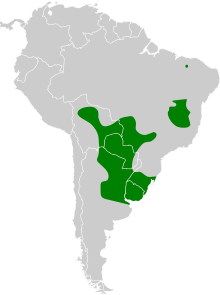Chotoy spinetail
| Chotoy spinetail | |
|---|---|

| |
| Scientific classification | |
| Domain: | Eukaryota |
| Kingdom: | Animalia |
| Phylum: | Chordata |
| Class: | Aves |
| Order: | Passeriformes |
| Family: | Furnariidae |
| Genus: | Schoeniophylax Ridgway, 1909 |
| Species: | S. phryganophilus
|
| Binomial name | |
| Schoeniophylax phryganophilus (Vieillot, 1817)
| |

| |
The chotoy spinetail (Schoeniophylax phryganophilus) is a species of
Taxonomy and systematics
The chotoy spinetail was originally described in genus
The chotoy spinetail has two subspecies, the

Description
The chotoy spinetail is 20 to 22 cm (7.9 to 8.7 in) long and weighs 15 to 22.5 g (0.53 to 0.79 oz). It is a large spinetail with a unique throat pattern. The sexes have the same plumage. Adults of the nominate subspecies have a white
Distribution and habitat
The nominate subspecies of the chotoy spinetail is by far the more widespread of the two. It is found in eastern Bolivia, Mato Grosso do Sul and Rio Grande do Sul in Brazil, most of Paraguay, northeastern Argentina as far south as northern Buenos Aires Province, and essentially all of Uruguay. Subspecies S. p. petersi is found disjunctly in northeastern Brazil's states of Minas Gerais, Bahia, and far separated in Piauí. The species inhabits a variety of open to semi-open landscapes including treed savanna; gallery forest, thickets, and scrub along watercourses; monte woodlands; and the edges of marshes. In elevation it ranges from near sea level to 500 m (1,600 ft).[4][8][9]
Behavior
Movement
The chotoy spinetail is a year-round resident throughout its range.[4]
Feeding
The chotoy spinetail feeds on arthropods. It typically forages singly or in pairs, gleaning prey from small branches and foliage within about 1 m (3 ft) of the ground.[4]
Breeding
The chotoy spinetail breeds in the austral spring and summer, roughly late September to January. It is thought to be monogamous. Its nest is a large ball of thorny sticks with an entrance tube on the side; the tube and inner chamber are lined with softer plant material. It is typically placed in a bush or small tree up to about 3.5 m (11 ft) above the ground but occasionally much higher. The clutch size is three to six eggs but usually four or five. The incubation period is 15 to 16 days and fledging occurs 13 to 14 days after hatch.[4]
Vocalization
The chotoy spinetail's song is "a distinctive series of low-pitched “cho” notes" that sound like they come from a larger bird.[4] It has been rendered as "rrrrtooo chicheetitichichicheecheychachochoochew".[9] Its call is a "hurried 'sreepsreeptrrit' ".[8]
Status
The
References
- ^ . Retrieved 20 November 2023.
- ^ Rasmussen, Pamela, eds. (July 2023). "Ovenbirds, woodcreepers". IOC World Bird List. v 13.2. Retrieved July 31, 2023.
- ^ Dictionnaire d'histoire naturelle (in French). Vol. 11. Paris. 1817. p. 207.
- ^ a b c d e f g h Remsen, Jr., J. V. (2020). Chotoy Spinetail (Schoeniophylax phryganophilus), version 1.0. In Birds of the World (J. del Hoyo, A. Elliott, J. Sargatal, D. A. Christie, and E. de Juana, Editors). Cornell Lab of Ornithology, Ithaca, NY, USA. https://doi.org/10.2173/bow.chospi2.01 retrieved November 20, 2023
- ^ Derryberry, E. P., S. Claramunt, G. Derryberry, R. T. Chesser, J. Cracraft, A. Aleixo, J. Pérez-Emán, J. V. Remsen, Jr., and R. T. Brumfield. (2011). Lineage diversification and morphological evolution in a large-scale continental radiation: the Neotropical ovenbirds and woodcreepers (Aves: Furnariidae). Evolution 65(10):2973–2986. https://doi.org/10.1111/j.1558-5646.2011.01374.x
- .
- hdl:10138/329703. A high resolution version of the phylogenetic tree in Figure 1 is available from the first author's website here.
- ^ ISBN 978-0-19-530155-7.
- ^ ISBN 0691090351.
External links
- Chotoy spinetail photo gallery VIREO
- Photo-Medium Res; Article chandra.as.utexas.edu–"Birds of Brazil"
- Photo-High Res; Article Tropical Birding


